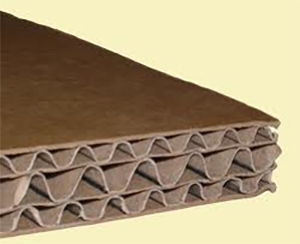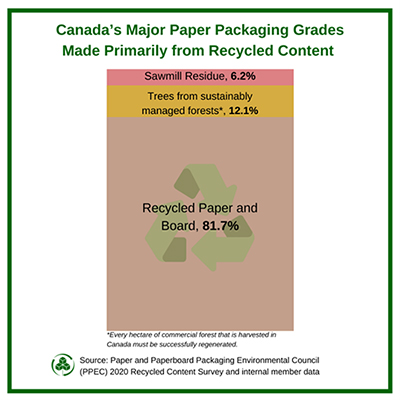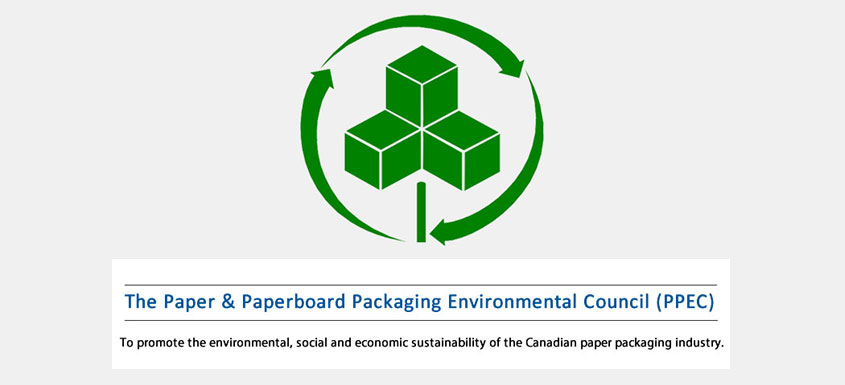In the November 28th New York Times Magazine article, Where Does All the Cardboard Come From? I Had to Know, writer Matthew Shaer does a deep dive on what he refers to as the “cardboard economy” – everything from the history of who invented it, how it’s made, and its global marketplace.
First off, to us at PPEC, while “cardboard” is a commonly used term that we all understand – the box our deliveries come in – the industry terms are a bit different.
A corrugated box is made from strong paper fibres, comprising a top and bottom layer of paper fibre known as linerboard, and a middle layer, called corrugating medium, which is the wavy part that gives the box its strength.
 Image adapted from The New York Times Magazine
Image adapted from The New York Times Magazine
While a boxboard or paperboard carton typically only holds a single item – i.e. cereal or shoes – it does not require the same strength properties as a corrugated box, so you won’t see any wavy ripples in those.
But back to the article. While it is mostly focused on the scale and size of the international market for corrugated packaging – which is expected to reach an estimated $205 billion by 2025, according to the article – it does refer to some of the environmental attributes of corrugated packaging, noting that it is “more recyclable than other shipping methods,” and even likens it to a classic fairy tale:
“Corrugated packaging has a Goldilocks quality to it,” says Tim Cooper, a project director for the market-research and testing firm Smithers. “It’s easy to produce, it’s strong and it’s sustainable, because unlike plastic, it comes from a renewable resource.”
We agree that it is strong and sustainable, but there is nothing fictional about the environmental sustainability of corrugated packaging. What Goldilocks needs to understand is that not only is it recyclable, it is actually and actively recycled, allowing it to be reused again and again.
Using recycled content is an inherent part of the Canadian paper packaging industry’s operations. PPEC member mills have been using recycled paper fibres for decades. It makes environmental and business sense to recycle and reuse old paper packaging, including Old Corrugated Cardboard, so it can be remade into new paper-based packaging products again and again, keeping valuable raw material out of landfill.
 Image of linerboard corrugating medium
Image of linerboard corrugating medium
While the New York Times article reports on its high recycling rates in the U.S., it does not discuss the importance of recycled content, making it sound like boxes are made mostly from trees.
In fact, trees are mentioned in the article 16 times, while recycling is mentioned 11 times.
The sustainable management of forests, and what happens after consumers and businesses recycle their boxes is not mentioned, which may perpetuate the myth that paper-based packaging primarily uses trees in the manufacturing process, which is simply untrue.
In Canada, the average recycled content for domestic shipments of containerboard, which is used to make corrugated boxes is 86.5%, and nearly 80% for boxboard, according to PPEC’s Recycled Content Survey.
The remaining materials used in the mix include sawmill residues and some virgin fibres from responsibly sourced forests. But to be clear, the Canadian paper packaging industry doesn’t use much in the way of freshly cut trees, and the little that is harvested must be successfully regenerated by law. In 2019, the total forest harvest (for lumber and all paper grades including packaging) represented 0.2% of Canada’s forest land, according to The State of Canada’s Forests Annual Report.

We don’t take issue with the New York Times article itself, it is a well-researched piece on what has become a preferred packaging choice, and we expect there will be a continued shift towards paper-based packaging, especially as governments consider banning some types of materials, similar to Canada’s ban on single-use plastics.
But, articles like this should also talk about the critical role that recycling plays in the sustainability of the paper packaging industry. That must be part of any story about corrugated and paper-based packaging because it is an inherent part of our industry’s story.
When we use and recycle paper-based packaging, we all play a part in protecting and replenishing our renewable resources, contributing to the sustainable management of Canada’s forests, and supporting the circular economy of the paper-based packaging industry through the important act of recycling.
 Rachel Kagan
Rachel Kagan
Executive Director
The Paper & Paperboard Packaging Environmental Council (PPEC)













